Choosing the right credit card in the Philippines today is like choosing the right plan for your internet—too many promos, too many options, and plenty of fine print. And yet, having the right card in your wallet can make life easier. You can spread out big purchases, build your credit score, get perks on groceries or travel, and even earn cashback or rewards. But how do you decide which card actually fits your needs?
That’s what this guide is for. We’re diving deep into the best credit cards in the Philippines for 2025, not just by bank or by top picks, but by real-life use cases, fees, features, and Filipino spending habits. Whether you’re a young pro just getting your first card or a seasoned earner looking for perks and miles, we’ve got you covered.
- Credit Cards in the PH: The 2025 Landscape
- Best Cashback Credit Cards
- Best Rewards Credit Cards
- Best Travel Credit Cards
- Best NAFFL Credit Cards
- Who Should Get a Credit Card in 2025?
- Common Requirements for Credit Card Applications in the Philippines
- Key Features to Consider Before You Apply
- Credit Card Myths: Misconceptions Among Filipinos
- Tips for First-Time Credit Card Users
- Conclusion: Picking the Right Card Is Personal
Credit Cards in the PH: The 2025 Landscape
Credit card usage in the Philippines has grown fast. According to the Credit Card Association of the Philippines (CCAP), there were 2.1 million active credit cards in the Philippines as of March 2024. More banks are making their application processes digital, and approvals are faster than ever. This means more Filipinos, from Gen Z to retirees, are now using credit cards for everyday needs.
Banks have also responded by diversifying their card offerings. You’ll now see co-branded cards with e-commerce platforms (like Lazada or Shopee), travel cards with airline tie-ins, and even entry-level cards that are low on fees but high on accessibility.
The thing is, not every card is created equal. And just because a card offers high cashback or rewards doesn’t mean it’s sulit for you. That’s why it’s important to align your card choice with how you actually spend.
Let’s look at the top credit cards that stand out based on category.
Best Cashback Credit Cards
If you’re the type who’s all about sulit purchases, like getting a bit back every time you spend, then cashback cards are for you. These are ideal for budget-conscious Filipinos, families doing regular grocery hauls, or anyone who uses their credit card for bills, gas, and daily essentials. It’s a practical choice that lets you earn money back while spending on the usual stuff.
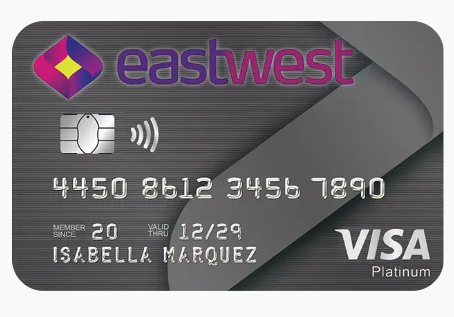
EastWest Visa Platinum
Offers 8.88% cashback on straight payments used for shopping, dining, deliveries, travel booking, hotels, vehicle rentals, fuel, and utilities. Get an additional 0.3% on all other categories. Also offers up to a ₱7 discount on Unioil fuels.
Monthly Cap: 1,250
Annual Fee: ₱3,600 (waivable with a ₱1.5M spending requirement).

BPI Amore Cashback
For every ₱1,000 spent, it offers 4% cashback on supermarkets and groceries, 1% cashback on drugstores and utilities, and 0.3% on all other local retail spending, whether online or in-store.
Annual Cap: ₱15,000
Annual Fee: ₱2,050 (waivable with a ₱180k-250k spending requirement).
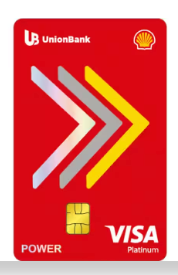
UnionBank Shell Power Visa Platinum
Offers up to a 5% (₱12 until June 2025) rebate on Shell fuel, RFID loads, auto repair services, and maintenance. With a 10% discount on Shell oil change packages and one 24/7 emergency roadside assistance per year.
Annual Cap: ₱15,000
Annual Fee: ₱2,800 (offered as NAFFL depending on the existing promo).
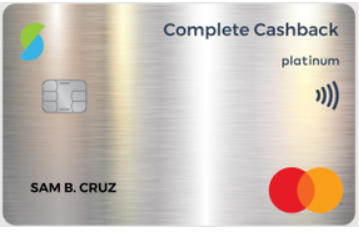
Security Bank Complete Cashback
Offers 5% cashback on groceries, 4% on gas, 3% on utilities, 2% on dining, and 1% on shopping spending.
Monthly Cap: ₱1,000
Annual Fee: ₱3,000 (non-waivable).
Best Rewards Credit Cards
Prefer earning points and exchanging them for flights, gadgets, or gift certificates? Rewards cards are great for frequent spenders who love maximizing every swipe. They’re best for those who use their card often, whether for online shopping, dining out, or even business expenses, and want perks in return.

RCBC Flex Visa
Earns double reward points on two chosen categories. Reward conversion is dependent on spending categories.
Estimated Conversion: Spend ₱165 to get ₱1 reward*
Annual Fee: ₱1,500 (waivable with spending requirement).
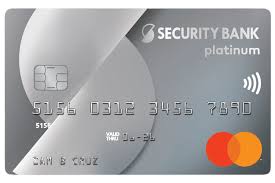
Security Bank Platinum Mastercard
Earns two non-expiring points for every ₱20 spent across all categories.
Estimated Conversion: Spend ₱334 to get ₱1 reward
Annual Fee: ₱4,000 (waivable with conditions).
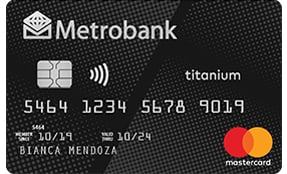
Metrobank Titanium Mastercard
Earns 1 non-expiring point per ₱20 spent. This point is doubled for online, department store, and dining transactions.
Estimated Conversion: Spend ₱600 to get ₱1 reward*
Annual Fee: ₱2,500 (waivable with a ₱250k spending requirement).

RCBC Hexagon Club
Earns 1 point for every ₱36 spent on dining, shopping, travel, and more. Also, get 1 point for every ₱125 spent on service merchants and ₱250 spent on utility bill payments.
Estimated Conversion: Spend ₱238 to get ₱1 reward*
Annual Fee: NAFFL (must maintain a savings account with ₱100,000 ADB).
*computed based on the highest earning category
Best Travel Credit Cards
For jetsetters, OFWs, or even weekend warriors planning frequent getaways, travel credit cards offer big advantages. Think air miles, free travel insurance, airport lounge access, and exclusive promos with airlines. If your lifestyle includes regular flights or hotel bookings, this section is for you.
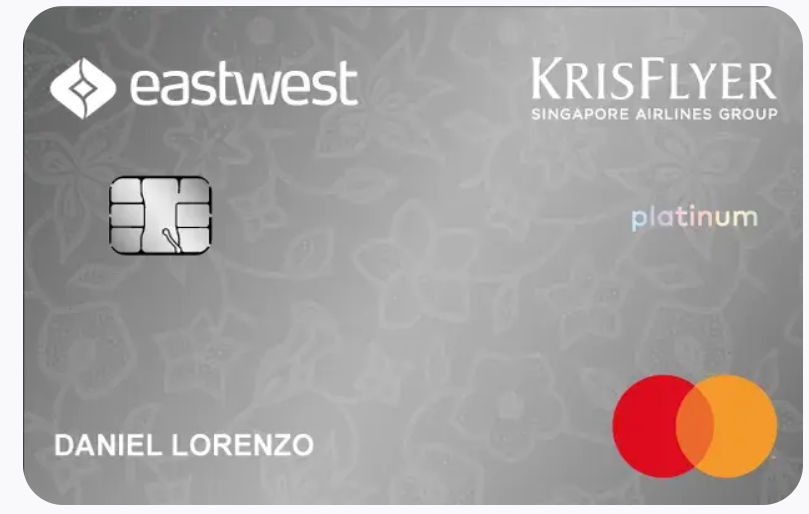
EastWest KrisFlyer Platinum Mastercard
Enjoy a low foreign currency conversion rate of 1.70%, airport lounge access, free comprehensive travel insurance, and KrisFlyer miles.
Earn 1 Krisflyer mile for every:
- ₱15 spent on Singapore Airlines, Scoot, KrisShop, travel agencies, hotels, resorts, cross-border
- ₱45 spent on other airlines, local spend on e-commerce, dining
- ₱88 spent on local essential
- Additional 3,000 KrisFlyer miles for an accumulated cross-border amount of ₱200,000 within 3 months from card activation date
- Additional 5,000 KrisFlyer miles for an accumulated cross-border amount of ₱100,000 within 12 months from card activation date
Sample Conversion: Spend ₱484,000 on local essentials to get a one-way ticket from Manila to Singapore (assuming the bonuses 3,000 + 5,000 KrisFlyer miles are received; Singapore Airlines).
Annual Fee: ₱4,000 (non-waivable).

BPI Visa Signature Card
Enjoy a low foreign currency conversion rate of 1.85%, airport lounge access, free comprehensive travel insurance, and 2x BPI points for every ₱20 spent.
Sample Conversion: Spend ₱600,000 to get a one-way ticket from Manila to Singapore via PAL or spend ₱475,000 to get a one-way ticket from Manila to Hong Kong via Cathay Pacific.
Annual Fee: ₱5,500 (waived for preferred clients or with ₱1.2M spending requirement ).
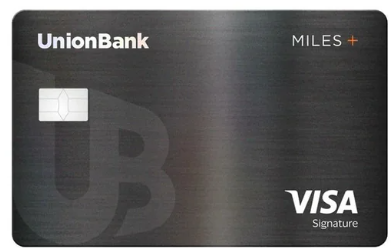
UnionBank Miles+ Visa Signature
Enjoy airport lounge access, e-commerce protection, comprehensive travel insurance, and earn 1 UB mile for every ₱30 spent.
Estimated Conversion: Spend ₱336,000 to get a one-way ticket from Manila to Hong Kong via Cathay Pacific.
Annual Fee: ₱5,000 (UB is known to be strict in waiving AF).

RCBC Visa Platinum
Enjoy airport lounge access, free comprehensive travel insurance, e-commerce protection, and Preferred Airmiles.
Earn 1 Preferred Airmile for every:
- ₱25 spent on non-service overseas transactions.
- ₱48 spent on non-service domestic transactions.
- ₱125 spent on service merchants (supermarket, gas, drugstore)
- ₱250 spent on utility bills payment
Estimated Conversion: Spend ₱336,000 on non-service domestic transactions to get a one-way ticket from Manila to Hong Kong via Cathay Pacific.
Annual Fee: ₱5,000 (waivable; condition varies).
Best NAFFL Credit Cards
Not ready for high-maintenance cards? NAFFL credit cards are perfect for first-timers, students, and practical users who want the convenience of a credit card but without the yearly cost. They’re simple, budget-friendly, and still come with useful perks, ideal if you’re just starting your credit journey or want a backup card that won’t cost a thing long-term.
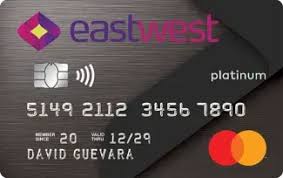
EastWest Platinum Mastercard
Offers no annual fee for life, priority pass membership on airport lounges, free comprehensive travel insurance, and a virtual credit card for safe online transactions. Also earns 1 Platinum Rewards Point for every ₱40 spent on partner establishments.

PNB Ze-Lo Mastercard
Offers no annual fee for life for the primary and supplementary cards, no late payment fees, no overlimit fees, low minimum amount due, and a lower finance charge of 2.5%.

UnionBank U Visa Platinum/Platinum Mastercard
Offers no annual fee for life, 10% interest back, no overlimit fees, and no late fees.

Metrobank M Free Mastercard
Offers no annual fee for life, 0% installment programs, and allows conversion of credit limit to cash via Cash2Go.
Who Should Get a Credit Card in 2025?
Let’s answer the common question first: “Kailangan ko ba talaga ng credit card?”
The answer depends. If you’re trying to build a credit history (lalo na kung gusto mong kumuha ng future loans), a credit card is a good place to start, as long as you use it responsibly. If you pay your dues on time and keep your balance low, it can help you qualify for car loans, housing loans, or business loans later on.
Credit cards also offer a level of convenience and protection that debit cards don’t. For example:
- You can dispute fraudulent charges.
- You often get purchase protection or travel insurance.
- Some promos are exclusive to credit card holders (think 0% installment on appliances).
But if you’re the type who easily overspends or struggles with discipline, it’s better to hold off. Credit card debt, lalo na with current interest rates at around 3% per month, can grow fast and spiral out of control.
Common Requirements for Credit Card Applications in the Philippines
Applying for a credit card isn’t as intimidating as it sounds—lalo na ngayon na marami nang banks ang may online application portals. But still, each bank has its own set of requirements. Here’s a general idea of what you’ll need:
For First-Time Applicants:
- Valid Government ID (e.g., passport, driver’s license, UMID)
- Proof of Income: Payslips, Certificate of Employment, or ITR
- Minimum Gross Annual Income: Usually starts at ₱120,000 to ₱300,000, depending on the card
- Proof of Billing: Utility bills under your name or your household’s name
- TIN and/or SSS Number
If You Already Hold Another Credit Card: Banks are generally more lenient if you’re applying with an existing credit card. Most banks will just ask for:
- A copy of your latest credit card billing statement
- Proof of income (sometimes waived or relaxed)
- Valid ID and application form
Having a good repayment history on an existing card boosts your chances significantly. Some even offer fast-track or pre-approved options through email or app invites. Kaya kung may existing card ka na, don’t hesitate to ask your current bank for an upgrade, or shop around for better perks.
Key Features to Consider Before You Apply
Don’t just apply for a card because you saw it in a mall booth or on TikTok. Here’s what you really need to evaluate:
- Annual Fees: Some cards waive these for the first year, some forever. BPI, PNB, and UB are known for low-fee or no-fee cards.
- Interest Rates: Standard rate is around 2-3% monthly. If you plan to revolve your balance, look for lower-interest cards.
- Rewards or Cashback: Do you want points or cash rebates? Each system has pros and cons.
- Spending Categories: Match the card’s perks with where you usually spend—groceries, gas, dining, travel, and online shopping.
- Income Requirements: Most cards require a gross annual income of ₱120,000 to ₱420,000, but some are stricter than others, depending on the card type.
- Digital Access: A good mobile app makes it easier to track expenses and avoid surprises. UnionBank and RCBC lead the pack here.
You should also ask yourself: Am I disciplined enough to pay my bill in full? Kasi kahit gaano ka-generous ang rewards program, it’s not worth it if you’re paying interest every month.
Credit Card Myths: Misconceptions Among Filipinos
“Masama ang credit card, utang lang ’yan.”
Let’s clear that up. A credit card is a tool—it can be harmful if misused, but powerful if used right. If you pay in full each month, you’re not paying interest. You’re basically using the bank’s money for free for 30+ days.
“Sayang lang ang points, wala namang value.”
Rewards can actually save you money if you use them well. For example, Metrobank and RCBC allow you to use points for groceries, airline tickets, or statement credits.
“Hindi ako ma-approve kasi wala akong malaking sweldo.”
There are cards for low-income earners. The key is a clean credit record and proof of stable income, kahit freelance pa ’yan. Some banks also accept utility bills and GCash transactions as part of their screening process.
Tips for First-Time Credit Card Users
- Start with one card. Don’t apply for 3 cards all at once. Banks frown upon multiple applications in a short time.
- Set a spending cap. Treat your card like a debit card. Don’t spend what you can’t pay off.
- Use the mobile app. Most apps let you set notifications, track due dates, and even freeze your card if it gets lost.
- Monitor fees. Watch for sneaky charges—overlimit fees, late payment charges, and foreign transaction fees.
- Automate payments. If possible, enroll your card in auto-debit to avoid missing payments.
Conclusion: Picking the Right Card Is Personal
Ultimately, the best credit card for you will depend on your lifestyle, goals, and discipline. If you’re building credit, go for beginner cards with low fees. If you want perks, choose cards that give rewards for what you already spend on. And if you’re after flexibility and control, find one with a strong mobile platform and responsive customer service.
In 2025, Filipino consumers have more options than ever—and that’s a good thing. Just make sure to choose wisely. Kasi sa huli, it’s not about having the flashiest plastic in your wallet, but the one that helps you move forward.
Disclaimer: This guide reflects independent editorial research and recommendations by The Data Code as of Q1 2025. Always verify terms directly with issuing banks.
Explore By Bank












